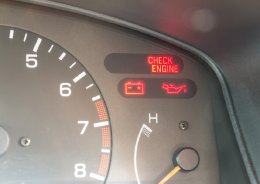
Almost all cars have an engine control unit (ECU), which is a computerized engine management system that controls all the operations of the engine and the transmission. This facilitates the high performance of the engine, and also ensures that the emissions are well in check. These ECUs have self-testing abilities, which tell us about engine trouble, as soon as it appears. Although the sensors themselves are on the periphery of the engine, they work as an early-warning system that tell you that not all may be well with your car. One such indicator is the Check Engine light on your instrument console. This indicator lights up when there is a problem with the engine. Before you go about addressing the issues with your car, you need to learn about the location and function of the check engine light.
Check Engine LightThe malfunction indicator lamp (MIL) or the check engine light, is an indicator of a malfunction in the electronic control module of an automobile. Typically, this indicator is found on the instrument console of the vehicle. In some older automobiles, this was labeled as ‘engine’ or ‘trouble’, which indicated minor problems, like overheating or low oil pressure in the engine. The check engine light is generally amber or red in color, and has two stages, viz. a steady light and a flashing light. A steady light usually indicates minor problems, while the check engine light flashes only when there is a serious problem with your car.
Causes of Check Engine Light FlashingMost cars have a simple check engine sign that lights up when the car isn’t functioning as it should. If you have an OBD (on-board diagnostic) code scanner, you can pinpoint the problem area, without making a trip to the mechanic. If, however, you aren’t the over adventurous sorts, then the safest bet would be to take the car to the workshop at the earliest. If you still feel like experimenting, or simply want to know what could be wrong with ‘her’, here’s a look at what this light usually points out to.
 Engine MisfireThe check engine light flashing can be an indicator of the engine misfiring, which could lead to serious damage to the catalytic converter.
Engine MisfireThe check engine light flashing can be an indicator of the engine misfiring, which could lead to serious damage to the catalytic converter.
 Malfunctioning Emission Control SystemAlong with the catalytic converter problem, the blinking of the check engine light could also point towards a problem in the emission control system of the engine. This system consists of many active sensors that control the amount of pollutants released by the vehicle.
Malfunctioning Emission Control SystemAlong with the catalytic converter problem, the blinking of the check engine light could also point towards a problem in the emission control system of the engine. This system consists of many active sensors that control the amount of pollutants released by the vehicle.
 Faulty Oxygen SensorsThe flashing light can also be a denotation of dysfunctions in the oxygen sensors, which read the ratio of fuel and air inside the engine.
Faulty Oxygen SensorsThe flashing light can also be a denotation of dysfunctions in the oxygen sensors, which read the ratio of fuel and air inside the engine.
 Worn-out Spark Plug Wire
Worn-out Spark Plug Wire
Another cause of engine misfire is the aged spark plug wires becoming weak and brittle. If your check engine light flashes and then stabilizes when you start the engine, you need to turn off the engine immediately and check the spark plug wires, using the OBD code. If the wires are worn out, you might want to get them replaced at the earliest.
 Loose Gas Cap
Loose Gas Cap
Another thing that gets the check engine light flashing away frantically is a gas cap that hasn’t been shut tight. In such cases, the light stops blinking as soon as the gas cap is tightened.
In any and all cases, if the check engine indicator lights up, or flashes constantly for more than a day, you would be well-advised to take your car over to the service center, and let the experts handle it. Avoid driving the car if the light is on, more so if it is flickering.
It is important not to confuse the check engine light with the maintenance light of the vehicle, that illuminates when the vehicle servicing is due. Timely servicing, and proper maintenance, along with a good understanding of the warning signs that the car shows, will help to ensure that your drive remains bump-free.